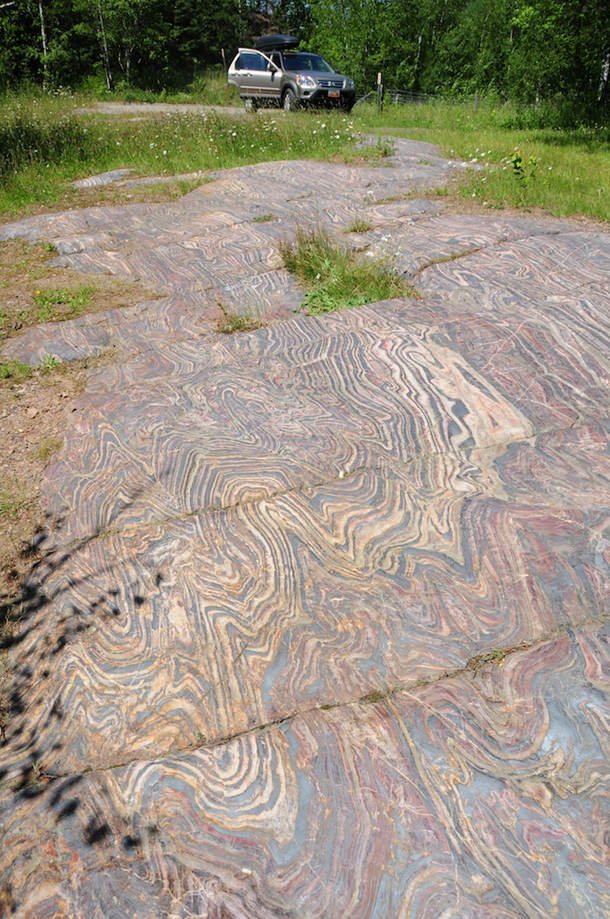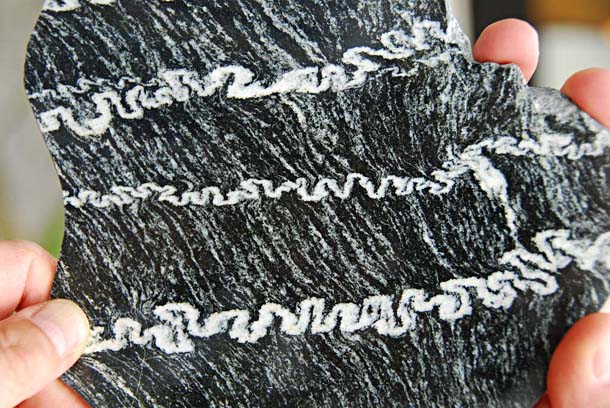14 January 2011
Friday fold(s): a few from Fossen
Posted by Callan Bentley
Last year, Haaken Fossen of the University of Bergen, Norway, published a full-color structural geology textbook called Structural Geology. So far, I think it is absolutely boffo. I’m reading it this semester as I teach structure at George Mason University, using my old standby text, George Davis and Stephen Reynolds’ Structural Geology of Rocks and Regions. I may switch to Fossen’s text next year. Certainly the imagery is enticing…
In exploring the online resources for the text, I was pleased to discover full-sized digital JPG files (600 dpi) for all the figures in the text. Nice! I was so taken with some of the fold images, that I e-mailed Dr. Fossen and asked him if I could feature a couple here as the “Friday fold.” He willingly granted me permission, and so I am pleased to present two eye-popping folds from his collection:

Folded banded iron formation with shale interbeds, exposed in a pavement near Soudan, Minnesota.

Buckled granitoid dikes within a gneiss from the Jotun Nappe, in the Norwegian Caledonides. The age of the folding is probably Grenvillian.
A full gallery of Fossen’s fold photos can be found at this link. If you click it, prepare to ooh and ahh for ten minutes or so.
Thanks to Dr. Fossen for permission to republish these images here.


 Callan Bentley is Associate Professor of Geology at Piedmont Virginia Community College in Charlottesville, Virginia. He is a Fellow of the Geological Society of America. For his work on this blog, the National Association of Geoscience Teachers recognized him with the James Shea Award. He has also won the Outstanding Faculty Award from the State Council on Higher Education in Virginia, and the Biggs Award for Excellence in Geoscience Teaching from the Geoscience Education Division of the Geological Society of America. In previous years, Callan served as a contributing editor at EARTH magazine, President of the Geological Society of Washington and President the Geo2YC division of NAGT.
Callan Bentley is Associate Professor of Geology at Piedmont Virginia Community College in Charlottesville, Virginia. He is a Fellow of the Geological Society of America. For his work on this blog, the National Association of Geoscience Teachers recognized him with the James Shea Award. He has also won the Outstanding Faculty Award from the State Council on Higher Education in Virginia, and the Biggs Award for Excellence in Geoscience Teaching from the Geoscience Education Division of the Geological Society of America. In previous years, Callan served as a contributing editor at EARTH magazine, President of the Geological Society of Washington and President the Geo2YC division of NAGT.
[…] This post was mentioned on Twitter by Callan Bentley, Chris Rowan. Chris Rowan said: Friday fold(s): a few from Fossen http://bit.ly/dT5LpB […]
ZOMG so drooling right now…. Thank you, Dr. Fossen!
That noise you hear that resembles cats in a blender is my bookshelves screaming as I inform them another textbook shall soon be added to their burden…
I’m taking a structural course right now, and we’re using the book by Haakon Fossen, and it’s amazing. It was rather cheap for such a quality textbook ($80 Canadian, where most textbooks are somewhere between $100-200), and it explains concepts in simple language but without dumbing it down. The Appendix (B) on stereonets is a great resource when trying to figure out how the heck to use a stereonet. Plus the photos… The full-colour is amazing. This is probably the best textbook I have ever bought.
Wheee! Such pretty, pretty pictures.
I know Haakon personally and I am glad to hear that you like his text book. My advisor, Rich Schultz (Univ. Nevada, Reno), was enamored by the Norwegian version and we both eagerly waited for the English version. Since I might be teaching structural geology in the (hopefully not too distant) future, these comments might make choosing a book that much easier! Thanks.
I’ve been to that outcrop in Minnesota–too fabulous for words! The lore passed down to me as a grad student was that a Master’s degree was awarded to some lucky soul based upon a study of that outcrop alone, under the tutelage of the Master of Folds himself, Dr. Peter Hudleston:
http://www.geo.umn.edu/people/profs/HUDLESTON.html
[…] is a famous pavement outcrop of polyphase-folded banded iron formation (BIF) near Soudan, […]
I have great difficulty imagining the formation of the buckled granitoid dikes in gneiss in the lower image with 3 molten granite dikes in the space of 5 centimeters forcing their way through the perpendicular layering in such a meandering path with such extraordinary dike-width control.
(For the purposes of discussion, let’s say you’re holding the rock sideways to how it was formed such that the layering was laid down horizontally.)
Instead, I suggest that the alternate horizontal leucosome/melanosome layering is composed of authigenic mineral grains laid down in an aqueous setting similar to the banded iron formation in the image above it. Then suppose the grainitoid ‘dike’ is merely a membrane composed of crystallized quartz and feldspar mineral grains with some gelatinous component to give it mechanical competency which allows it to vertically bunch up on a millimeter scale to give it the meandering pattern. And the three ‘dikes’ are merely the transects of a single broad membrane folded horizontally on a centimeter scale, cutting through the membrane at three points like a dollar sign ‘$’.
Now admittedly, for authigenic mineral grains to precipitate, crystallize and settle out of suspension in the size range typically found in gneiss, the buoyancy would have to be lower than that found in earth’s oceans, but just right for a smaller planetesimal formed around the resonances of the hypothetical binary companion to our sun (Tyche). (I’m suggesting that the hypothetical planet ‘Tyche’ suggested by the astronomer John Matese is actually a binary companion to our sun: same idea but you get 2 for 1.)
In this senario, Tyche may have walked through the Oort cloud forming planetesimal comets with differentiated granite and gneiss cores for the past 4 billion years in the age range discovered by geochronology. A binary companion to the sun could raise its solar orbit through secular perturbation of its binary pair by feeding off the energy and angular momentum of the binary pair. In this way our solar system could have formed as a multiple star system from which hierarchy emerged in the form of a binary companion that has walked from the inner solar system out to 20,000 AU, flattening the inner Oort cloud as it went and forming differentiated planetesimal comets along the way including those of the late heavy bombardment 3.8 – 4.1 Ga when Tyche ran into the densest concentration of dust and gas at about 2000 AU.
The leucosome membrane would have formed at the ice-water boundary where silica solubility would be lowest and then would have become waterlogged and sank onto the more mafic mineral layers covering the core, crumpling to form the apparent ‘dikes’ in section view.
Primary Type I comets form mantled-gneiss-dome cores (composed of authigenic gneiss and hydrothermal schist and carbonate rock) with larger Type I compound planetesimal ‘platform’ cores composed of multiple gneiss domes and authigenic platform rock such as quartzite, shale and slate etc.
Primary Type II comets form granite pluton cores (composed of molten plutonic granite cores with hydrothermal greenstone mantles) with larger Type II compound planetesimal ‘batholith’ cores composed of multiple plutons and authigenic batholith rock.
The dikes didn’t intrude in a “meandering path” as you are envisioning – they intruded as roughly parallel planar features, and were later shortened parallel to that layering. The folding is a younger overprint of the original igneous intrusion. This sort of thing is pretty common, though not usually so succinctly expressed.
Your re-interpretation is rather extraordinary. By interpreting a gneiss as a sedimentary deposit, it harkens back to the ideas of Neptunism, an early school of geologic thought.